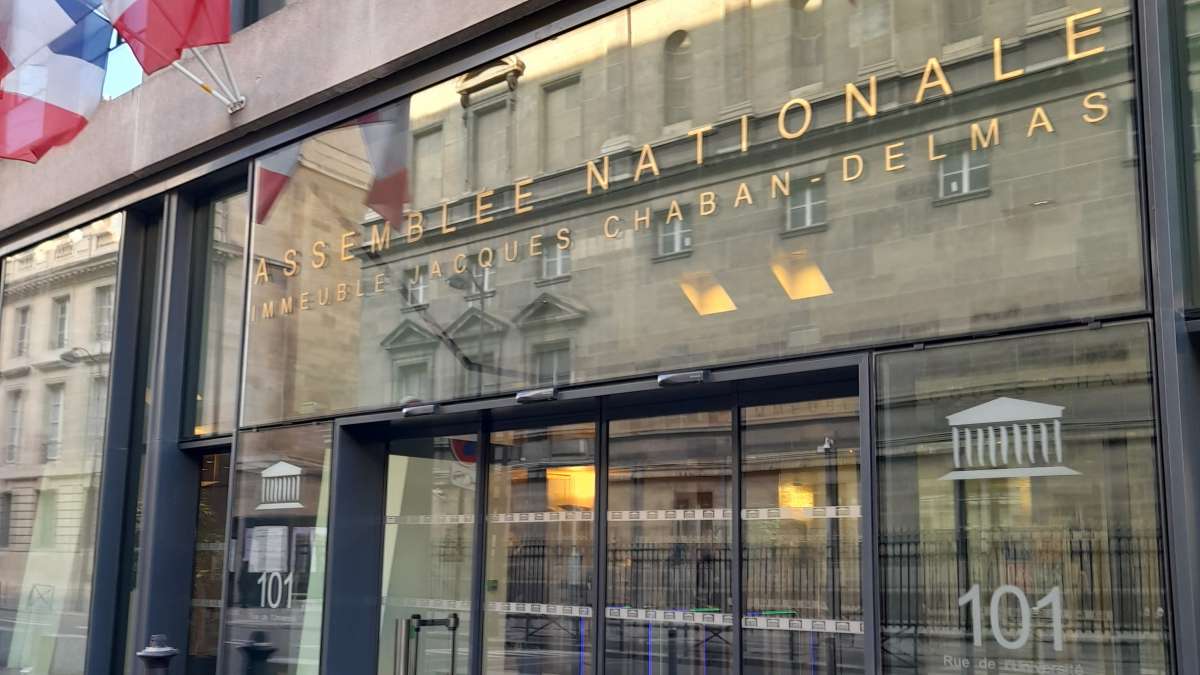
Laurence Maillart-Méhaignerie, President of the Sustainable Development of the Sustainable Development Commission, heard from for this round table :
-
Françoise Rossignol, president of the Club des villes et territoires cyclables (CVTC),
-
Olivier Schneider, president of the French Federation of Bicycle Users (FUB),
-
Camille Thomé, director of Vélo & Territoires,
-
Marion Ailloud, head of the " public space and urban roads" sector of the Centre for studies and Expertise on Risks, Environment, Mobility and Development (Cerema).

The health crisis, the social movements in the railway sector have accelerated the development of active modes: Are there lessons to be learned?
As an introduction, Françoise Rossignol, President of the CVTC, returned to the upheaval that has marked mobility practices in recent years: cycling and walking have been able to replace public transport or the use of the car for some journeys. She emphasizes this and notes that "the status of the bicycle has changed" with the LOM law and its application decrees, the "bike boost" type of financing (which has enabled 1.7 million bicycles to be repaired).
Positive indicators confirm this dynamic: the number of linear bicycle facilities has increased by 30% since 2018, 84% of communities surveyed by CVTC have one or more projects in their their program, 700 km of temporary facilities have been created and local players have been able to invent very diverse solutions, etc.
However, there is a strong disparity between areas. The increase in attendance has been lower in rural areas, and the transition to implementation has been faster in areas where work had been done upstream. She believes there is a strong case to be made for :
-
reducing disparities between territories,
-
perpetuating in a qualitative way the temporary arrangements the provisional arrangements made,
-
conduct important and interesting evaluation work, both financially and in terms of feedback.
In addition, Marion Ailloud, in charge of the Public Space and Urban Roads sector at Cerema completes this review of the health crisis by insisting on the challenges that had to be met during the decontamination: finding ways of moving around that allowed for physical distancing, to avoid a massive return to the car in a context in which public transport was in difficulty.
Walking and cycling have emerged as particularly efficient and resilient modes of transport. Cerema has supported this movement by rapidly producing 2 guides on temporary facilities for cyclists and pedestrians and by widely and pedestrians and by widely disseminating these new recommendations through various webinars.
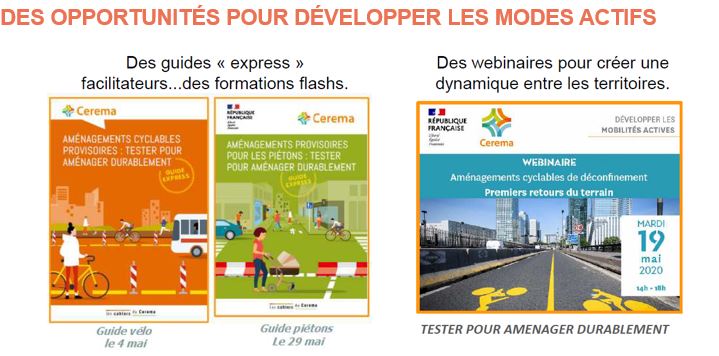
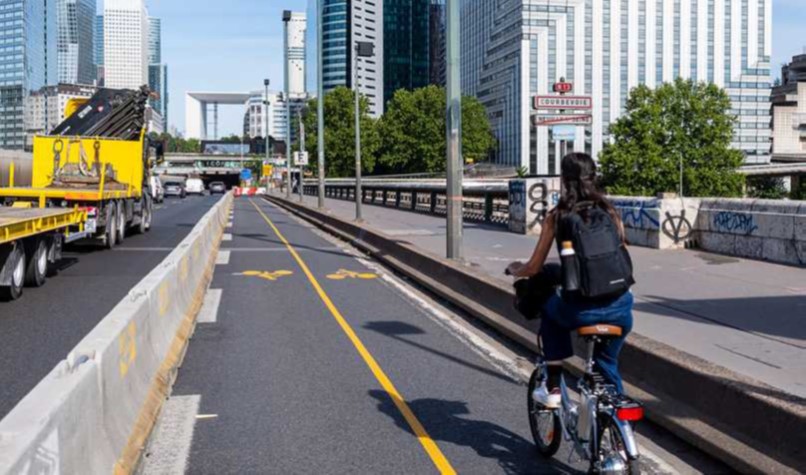
Cerema then quickly returned to the solutions solutions tested: reallocating lanes to the benefit of cyclists, widening existing bicycle facilities, provide new bicycle parking areas, reorganizing certain intersections to better accommodate cyclists, etc. Actions in favour of pedestrians have also been pedestrian priority zones, widening of sidewalks, traffic calming, and improvements of certain facilities such as schools, etc.
Olivier Schneider, President of the French Federation of Bicycle Users (FUB), describes the bicycle as an example of example of sobriety, but considers that it should not be limited to that. "The is a lever for the attractiveness of communities, for health, for employment... it is a way to create a vision of a desirable future, which would not be made only of deprivation".
This encouragement to travel by bicycle must be done while being aware of the reality in some areas, in which the inhabitants or visitors cannot do without a car. "We need to reconcile bicycle in the city with bicycle in the country, according to FUB. The potential of cycling is the same wherever you are in France.
Olivier Schneider indicates that INSEE* data indicate that everyone has a portion of their trips that are less than 7 km long and therefore have a "cycling potential". Hence the need to build a bicycle system that is inclusive, that "that allows your 12 year old daughter to go to middle-school by bike, or your 75 year old mother to cycle to the market to do her shopping". In this respect, FUB is delighted with the mission entrusted to MP Jean-Marc Zulesi, on "active mobility as a tool for preventing of loss of autonomy".
* Clarification provided by Cerema afterwards and outside this hearing: it is mainly the data from the EMC² and the data from the EMC² and the Survey Mobility of People (EMP, a national survey "cousin" of the of the EMC² carried out by Ministry of Ecological Transition, the latest update of which dates from 2019), which give us information on mobility practices and, in particular, distances. The INSEE data includes information only for employed people (place of residence, place of work, usual mode of travel in 6 categories: car, public transport, bicycle, 2WD, walking+skate, no walk+skate, no transport) and for school/students (place of residence, place of study, without information on modes). They do not allow the determination of the distances of home/work trips (one can make a detour to drop a child off at school, for example) or to have information on all the trips of the entire population (retired people, job seekers, etc.).

Develop the practice of cycling and walking for all in every areas
What should be funded as a priority in terms of purchasing assistance training? what needs in terms of technical and financial support for communities?
To allow the user to to acquire an eco-responsible bicycle
On aid for the acquisition of bicycles, FUB has pointed out the challenge of limiting the remaining expenses. Some people with modest incomes have difficulty to finance the purchase of a bicycle and the purchase or storage space. It is important that they have access to a banking offer to finance this project more easily. There is also a need to to extend this aid beyond the electric bicycle, so that they can also encourage the purchase of light bicycles without batteries.
FUB is particularly pleased that, as part of the recent climate and resilience law, the conversion premium (PAC ) has been extended to the purchase of an electric bicycle. However, she believes that the aid should also allow for the purchase of a "conventional bicycle", if the applicant considers that he or she can do without electric assistance.
In terms of sustainable mobility packages, she believes that the challenge is to systematize it and that we must put public and private sectors on an equal footing.
FUB and CVTC also point out the challenge of relocating at least at the European level, the production of certain spare parts or equipment, and to relaunch the repair aid system. FUB stresses the importance of the mission entrusted to deputy Guillaume Gouffier-Cha on the bicycle industry. It believes that repair is an important source of employment of jobs, provided that the parts are manufactured locally, and that training courses are put in place.
Train cyclists in their diversity: children, economically disadvantaged people... to develop the use of bicycles and the culture of sharing space
FUB and CVTC call for increased to intensify the "knowing how to ride a bike" (SRAV). An entire age group should be trained and that this be done systematically in schools. They also believe that communities should no longer be the only ones to to finance it. However, these actions cannot rely only on volunteers if we want to generalize them. The CVTC would also like it to be easier to mobilize certain municipal staff and if the links between the health services, youth and sports and the national education system were simplified.
The CVTC also believes that a challenge is to diversify the profiles of bicycle users: an ACV can be a suitable mode of transportation for a job seeker who would find training or a job within 10 to 15 km of their home.
Regarding the question of the difficulties posed by some configurations (e.g., two-way cycling) or even the cohabitation of pedestrians and bicycles or bicycles and cars, it seems to him that it is essential to communicate, to educate cyclists and motorists alike so that they understand each other's needs and the different uses. This is the case for the dual traffic lanes, but also for certain developments outside such as unmarked center lanes. We must also give ourselves time: some developments that are criticized at the outset are appreciated a few years later.
This is in line with FUB's approach, which is in favour of a "benevolent cyclist who is aware of the needs of other users, pays attention to them, and adapts his behaviour, his speed...
Increase funding and support communities
The CVTC has highlighted the need for a major effort in terms of funding: many communities have increased their bicycle budgets tenfold.
Camille Thomé, director of Vélo & Territoires, also believes that it is necessary to push funding in order to have "a complete bicycle system". According to the association :
-
more than 100,000 km of cycling facilities should be completed by 2030 (compared to what we have now),
-
these facilities must be safe and adapted to all, because the first obstacle to the practice is the fear linked to to safety,
-
the Active Mobility Fund (50 million per year) should be multiplied by 10 to reach a level of investment of 30 per year per inhabitant (on comparison with our Dutch and German neighbors) which is 4 times more than what is granted today.
The CVTC and Vélo & Territoires point out the following needs:
-
strengthen technical and financial engineering and develop expertise on the knowledge of cyclists' needs and cycling facilities; Cerema stresses in particular the need to develop technical recommendations for cycling facilities outside built-up areas;
-
facilitate access to funding windows: some calls for projects are very complex and only communities that have prepared for them in advance and are equipped to submit a solid application can apply;
-
encourage the assumption of responsibility for mobility by inter-municipalities.
Vélo & Territoires stresses that, in the face of these necessary investments, the practice of cycling contributes to the climate objectives and also generates revenue. Cycling is the second favourite activity of French people on vacation. France is the world's leading tourist destination, and the second for bicycle tourism behind Germany. A bicycle tourist spends more (68 euros per day per bicycle tourist, instead of 53 euros per day per tourist).
What are the recommendations in terms of planning and development?
Facilitating the transition from planning to implementation
Cerema reacted to the questions asked about planning and on ways to limit cycling discontinuities:
-
The planning tools, whether they are SCOT, PLU (which can identify routes to be created for active modes and urban cuts to be simplified mobility plans and specific plans and specific tools such as cycle master plans, pedestrian plans, accessibility plans for making road and public space facilities accessible. However, the stakeholders who produce these documents may be different from those who have the competence to create the facilities identified. There is therefore a strong challenge that is the transition between planning and operational implementation.
-
Cerema has taken the example of master plans for programmed accessibility in the transport sector and programmed accessibility agendas in the field of ERP (mandatory for accessible): setting a deadline, priorities, objectives to be reached, identify a "leader" ... are interesting levers for quickly undertaking the corresponding work (in particular the redesign of bus stops).
Develop and maintain intermodality to reconcile rural and urban areas
"We must rely on railways", say the CVTC and Vélo & Territoires.

In rural areas, all stakeholders agree on the importance of public transport, especially rail, to complement active modes. Encouraging bicycle-train travel would also bring users back to some of the smaller stations and maintain the rail network.

With regard to multimodal interchanges the interviewees agreed on the following 4 conditions for "successful this intermodality":
-
have the possibility to take their unmounted bike on trains and buses,
-
have secure parking in good conditions (security, tariffs, ticketing, information ticketing, information),
-
have access to a traveller information to identify whether it is possible and under what conditions,
-
have bicycle facilities to reach the hub.
Vélo & Territoires believes that it is necessary to ensure the implementation of the application decrees of the law on the orientation of mobility (LOM), particularly on secure bicycle parking around transit hubs. The future of mobility will have to give priority to low-carbon modes and a combination of bicycle-train / bicycle-CT will be fundamental. To achieve this, we need to simplify the bicycle/train user path, both for mobility, but also for travel related to tourism and leisure (the highest carbon emissions from tourism are linked to the means of transport to reach the tourist’s destination).
Making safer and more inclusive designs
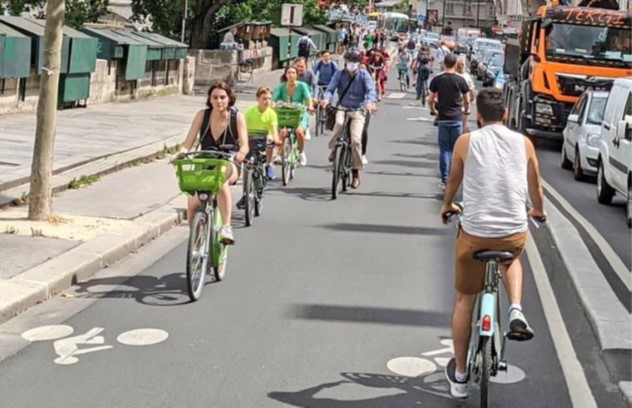
The interviewees were unanimous: the ambition is to allow everyone to feel comfortable and safe while walking or cycling, whether foot or by bicycle, whether they are a teenager, an elderly person, etc. The CVTC would like to see this practice become widespread: during the crisis, new users have appeared, "sometimes not as comfortable to circulate" as the more experienced historical public.
In terms of travel safety, FUB stresses the importance of making further progress on the issue of blind spots, which are unfortunately responsible for too many deaths and injuries. The Cerema and Vélo & Territoires emphasize the importance to work on reducing speeds, and not only in dense urban areas.
Cerema believes that areas are different in terms of what they need:
-
in the metropolitan areas and in large cities, it will be necessary to develop bicycle networks with high level of services, with particular attention to be paid to interactions between users (pedestrians/bicycles, bicycles/TC...) particularly at crossroads;
-
in sparsely populated areas, there is a real need to create a technical doctrine on cycling facilities outside agglomeration.
Regarding bicycle networks with a high level of service , FUB believes that one of the ambitions that could be supported in the context of the Paris Olympic and Paralympic Games 2024 could be to create a bicycle express network within 3 years. "It would be a question of heritage but also of exemplarity". It would send the message that in France, for short and medium trips, the "natural" mode of transport is cycling, or even walking for the shortest trips.
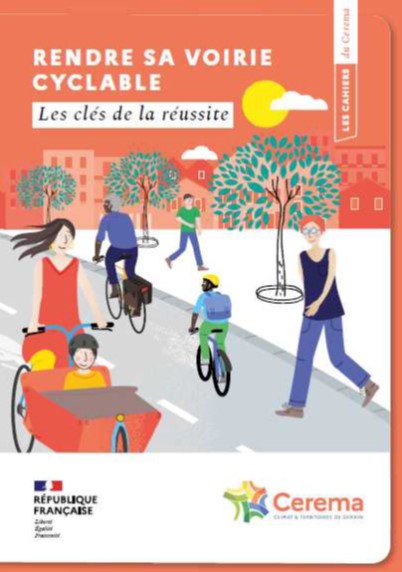
Cerema referred to its recent guide "Make your roadway cyclable".which sets out more ambitious objectives to facilitate cycling. The choice between mixing and separating modes is fundamental when seeking to build roadways that are adapted to all types of users. For cyclists, this choice is necessarily based on a prioritization of the bicycle network, or, failing to do that, a local review of the purpose of the installed facilities. On an axis where motorized traffic is significant, even if motorized vehicles are low, Cerema recommends creating a separate bicycle facility.
Concerning the question of the possibility for people in wheelchair to use bicycle paths, FUB is not opposed to this, while distinguishing certain cases: from the point of view of generously dimensioned bicycle paths (cyclo-logistics, transport of children in trailers…) as is the case in the Netherlands, wheelchair users will naturally be able to use them safely and without any inconvenience. Cerema reminds that a cycle track is a roadway according to article R.110-2 of the Highway Code, and that article R.412-35 of the Highway Code specifies that "the disabled in a wheelchair can circulate on the roadway in any case".
Rebalance the space in favour of active modes, including in low-density areas
In response to a question from a member of parliament on the difficulty of reconciling the development of development of bicycle facilities while limiting land artificialisation, Vélo & Territoires Territoires answered that the creation of these infrastructures (100,000 km would be necessary) should not be done by consuming new spaces, but by reallocating some spaces that are currently to the car.
This implies rethinking the sharing of roads, including in sparsely populated and very rural areas, and, for certain routes, to act on speeds in order to reduce the speed differential between cyclists and other motorized users, particularly on departmental roads. The French road network is very complete and many roads that are not used very often could be used for active modes.
Encouraging innovation
In response to a member's comment about the cumbersome of difficulties encountered in the development innovations, Cerema indicated that experiments to promote traffic in active modes active modes of transport in a safe manner and with limited energy consumption were to be encouraged. Solutions to improve the visibility of routes, to use light reflection... are interesting. However, some of them come up in a regulatory context that is difficult to change, especially when it comes to requirements set at the European level.
FUB is very much in favour of making exemptions easier to obtain. In the framework of the Académie des mobilités actives (ADMA) program, which CEE is piloting and in which Cerema is participating, it would like to equip project leaders to enable local authorities to develop innovative solutions, in particular on issues of road safety, legibility of space...
This work has been fully recorded and sequenced, and is available on the on the National Assembly’s website.

